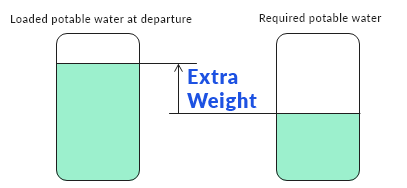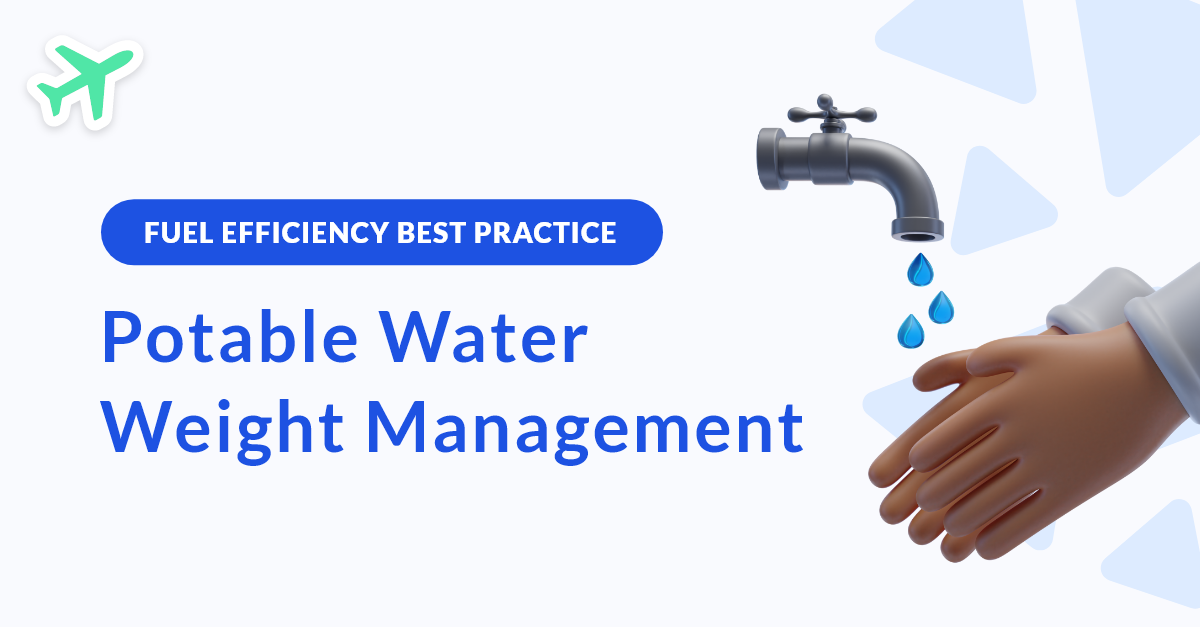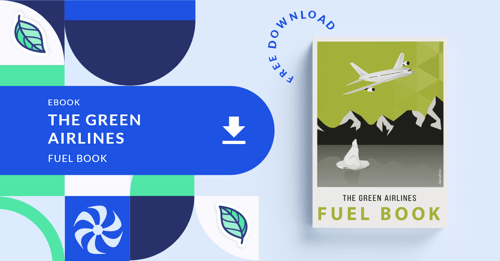Fly efficiently with better potable water management.
Potable water is water that is safe to be used as drinking water. In an aircraft, potable water is mainly used in the lavatory, but also for passengers’ drinks (water, coffee, tea) and even for showers in some first classes.
The potable water quantity to take onboard is defined during the flight planning according to the airline rules and potable water policy. It is then loaded into the aircraft's water tank by the ground crew before departure.
It is indispensable to load enough potable water to ensure passengers’ comfort during the whole flight. However, many aircraft have the capacity to carry more water than what is necessary for regular airline operations, and very few airlines have potable water policies in place (see IATA, 2011, page 188).
Unused Potable water: a major cost for airlines?
Estimating the appropriate quantity of potable water to carry onboard is not easy. Underestimating it may result in passenger discomfort, and water consumption can vary significantly between flights. However, overestimating it can lead to substantial costs.

Reducing the quantity of potable water is a simple initiative to reduce the weight carried onboard the aircraft.
In fact, any remaining potable water upon landing still has to be carried throughout the whole flight. This increases fuel consumption due to the added weight on the aircraft. To compute the impact of transporting this excess potable water, you must multiply the amount of unused water by the cost of weight (CoW). It represents the amount of fuel that is needed to carry the load of potable water.
A good rule of thumb to compute the cost of weight is to consider that it represents about 3.5% per flight hour. For example, 500kg of potable water unused during a flight of 9 hours will cost 150kg of additional fuel to carry to the destination.
Related Article >> How to use the cost of weight to be more fuel efficient?
In 2018, Finnair adjusted the standard water uplift volume, gaining annual fuel savings of 100 tons.
(see Finnair Sustainability Report 2018, p22). Since optimizing the potable water quantity can yield significant savings, it is interesting to investigate methods for managing potable water more efficiently without compromising passengers’ comfort.
How to optimize the amount of potable water on board?
The first step is to compute the required potable water quantity for the flight. If you know the number of passengers and the flight duration, by using an average consumption per passenger per flight hour, you can determine the required/optimal potable water quantity to load for this specific flight.
Knowing this average consumption per passenger per flight hour is key in determining the required and optimal amount of water to load for the flight. While the IATA standard of 0.3 L per passenger per flight hour is a reasonable estimate, accessing actual water consumption data from previous flights, accounting for flight duration, seasonality, time of day, etc., can provide more accurate insights.
That requires the ability to track the actual water uplift and arrival volumes. Remember, as Lord Kelvin once said, "You can’t improve what you don’t measure!".
Here are a few recommendations to optimize potable water load:
- The first step is to monitor the servicing compliance with planned potable water uplift, the water usage during flights, and the additional fuel consumption generated. With this first step, you can implement a standard potable water policy and monitor its application.
- For more advanced airlines on the subject, re-evaluating water servicing policies and including this in a more modern flight planning system to provide flight-specific recommendations are additional ways to achieve more fuel savings.
Related Article >> How to prepare for a fuel efficiency solution implementation?
In any case, an essential factor to consider when developing a potable water reduction program is to strike a balance between fuel efficiency and the economical amount of potable water uplift without jeopardizing passenger comfort. (IATA, 2011, page 191)
What results can you achieve by monitoring and adjusting potable water weight?
Based on IATA’s figures, the estimation of water quantity reduction per flight is around 550kg for long-range aircraft and 40kg for short-medium-range aircraft. For example, one B737 aircraft could represent 6000 kg of fuel burn savings a year. Imagine how much more you could achieve for a complete airline fleet…
Long story short, efficient potable water management can significantly benefit airlines in terms of fuel savings, reduced carbon emissions, and ROI. By accurately estimating the necessary amount of potable water required for each flight and minimizing the amount of excess water carried, airlines can achieve a fine balance between fuel efficiency and passenger comfort. If your objective is to reduce fuel consumption and carbon emissions further, then investing in a fuel management system capable of monitoring water-related data can offer significant savings to your airline.
References:
- IATA. (2011). Guidance Material and Best Practices for Fuel and Environmental Management (5th edition ed.). Montreal, Geneva. Chapter 9.3 Potable Water Servicing
- OpenAirlines Fuel Book Chapter 4 Section 3
- Finnair Sustainability Report 2018
LEARN MORE
Discover more airline fuel-saving tips & best practices in The Green Airlines Fuel Book >> Download the Ebook.



